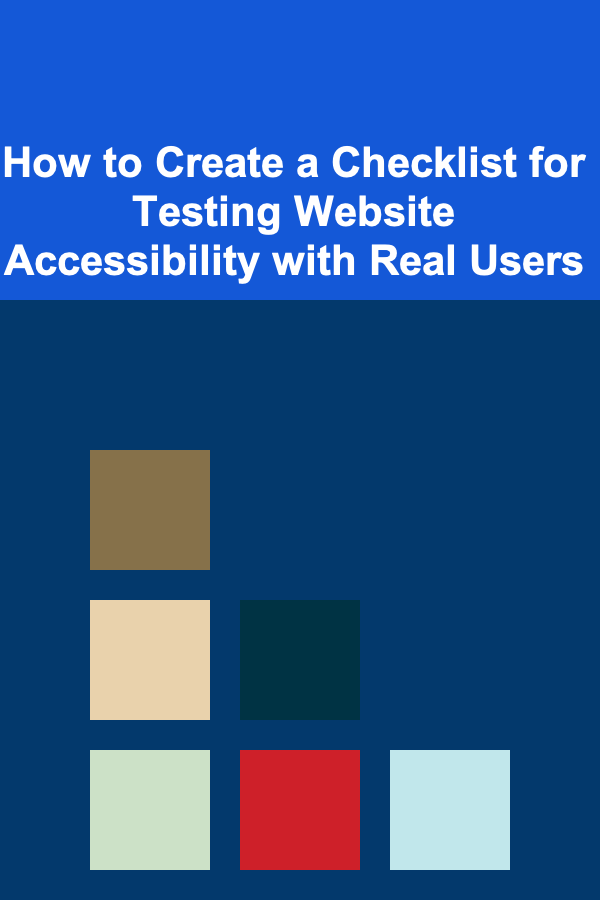
How to Explore Blockchain for Supply Chain Transparency
ebook include PDF & Audio bundle (Micro Guide)
$12.99$5.99
Limited Time Offer! Order within the next:

Supply chains are the backbone of global commerce, affecting everything from the delivery of raw materials to the final product reaching the consumer. However, traditional supply chains are often opaque, inefficient, and prone to errors, fraud, and counterfeiting. As supply chains become increasingly complex, tracking and verifying the movement of goods across vast networks of suppliers, manufacturers, and distributors can be challenging.
Enter blockchain technology---a revolutionary tool with the potential to enhance transparency, security, and traceability within supply chains. Blockchain's decentralized, immutable nature promises to streamline operations, increase trust, and reduce fraud. In this article, we will explore how blockchain can be applied to supply chains, examine its benefits, challenges, and the future of supply chain transparency enabled by this disruptive technology.
Understanding Blockchain Technology
Before delving into its application in supply chains, it is essential to understand blockchain technology itself. At its core, blockchain is a distributed ledger technology (DLT) that records transactions across multiple computers in such a way that the registered transactions cannot be altered retroactively.
Key Features of Blockchain
- Decentralization: Traditional databases rely on a central authority to validate and maintain records. In contrast, blockchain operates on a decentralized network, where multiple participants (nodes) share the responsibility of validating transactions. This reduces the risk of centralized control and manipulation.
- Immutability: Once a transaction is recorded on a blockchain, it is nearly impossible to change. This creates a permanent and transparent record of every transaction, which is particularly valuable for tracking the flow of goods and verifying authenticity.
- Security: Blockchain uses cryptography to secure data and prevent unauthorized access or tampering. Each transaction is encrypted and linked to the previous one, creating a chain of blocks that can only be accessed with the proper cryptographic keys.
- Transparency: Because every participant in a blockchain network has access to the same data, it increases transparency across the entire supply chain. Each participant can trace the path of goods, check the validity of transactions, and verify claims about product origins.
- Smart Contracts: These are self-executing contracts with the terms of the agreement directly written into code. Smart contracts automate and enforce agreements without the need for intermediaries, which can improve efficiency and reduce delays in the supply chain.
The Problem of Transparency in Traditional Supply Chains
Transparency is a significant challenge in traditional supply chains. In many industries, supply chains are often a "black box," where consumers, businesses, and even suppliers struggle to obtain accurate information about the origins, handling, and transportation of goods. Several issues contribute to the lack of transparency:
- Lack of Traceability: Many supply chains are fragmented, involving multiple parties in different countries and regions. This makes it difficult to trace the journey of a product from its raw material stage to the final sale.
- Data Silos: Companies typically maintain their own databases and systems for tracking products, which creates data silos. This can lead to discrepancies, errors, and inefficiencies when trying to reconcile data between different organizations in the supply chain.
- Fraud and Counterfeiting: Counterfeit products and fraudulent claims are major concerns in global supply chains. In industries like pharmaceuticals, luxury goods, and electronics, verifying the authenticity of products can be a daunting task.
- Ethical and Environmental Concerns: Consumers are increasingly concerned about the ethical and environmental impact of the products they purchase. Lack of transparency makes it challenging to verify claims related to sustainability, labor conditions, and environmental practices.
- Operational Inefficiencies: Traditional supply chain systems rely heavily on paper-based processes, manual record-keeping, and intermediaries, which can lead to delays, errors, and increased costs.
How Blockchain Enhances Supply Chain Transparency
Blockchain has the potential to solve many of the transparency issues in supply chains by providing a transparent, immutable, and secure way to track and trace products as they move through the supply chain. Below, we will explore several key areas where blockchain can enhance transparency in supply chains:
1. Product Traceability
With blockchain, every transaction in the supply chain can be recorded on a secure and transparent ledger. Each participant in the supply chain can access the same information in real time, allowing them to trace a product's journey from its origin to its final destination. This means that companies and consumers can easily verify the origin of raw materials, the manufacturing process, and the transportation route.
For example, in the food industry, blockchain can track a product's journey from farm to table. If a consumer purchases a bag of potatoes, they can scan a QR code on the packaging and immediately access the entire history of that product---when and where it was grown, how it was harvested, and how it traveled through the supply chain. This transparency can help reduce foodborne illnesses and enhance consumer trust.
2. Counterfeit Prevention
Counterfeiting is a major problem in industries such as pharmaceuticals, luxury goods, and electronics. Blockchain's immutable ledger can help prevent the circulation of counterfeit products by providing a verifiable history of each product's origin and movement through the supply chain.
For instance, in the luxury goods industry, blockchain can be used to create a digital certificate of authenticity for each item. By scanning a product's QR code or RFID tag, consumers can instantly verify whether the item is genuine or counterfeit. This not only protects consumers but also helps brands safeguard their reputation and prevent the loss of revenue due to fake products.
3. Smart Contracts for Efficiency
One of the most powerful features of blockchain is the use of smart contracts. These self-executing contracts automatically enforce the terms of an agreement between two or more parties. In a supply chain context, smart contracts can automate various processes, reducing the need for intermediaries and manual intervention.
For example, a smart contract could automatically trigger payment to a supplier once goods have been delivered and verified as compliant with the terms of the agreement. This reduces delays and ensures that all parties meet their obligations, which can improve the overall efficiency of the supply chain.
4. Enhanced Collaboration and Data Sharing
Blockchain can foster greater collaboration and trust between supply chain partners. Since all parties share access to the same transparent ledger, it is easier to resolve disputes, reduce fraud, and verify compliance with regulatory standards. Blockchain also eliminates data silos by providing a single, shared source of truth for all participants.
This collaborative environment is especially beneficial in industries with complex supply chains, such as manufacturing, automotive, and pharmaceuticals, where multiple suppliers and distributors must work together to deliver a final product. With blockchain, all parties can access real-time information, reducing the risk of errors and delays.
5. Environmental and Ethical Tracking
Consumers are increasingly concerned about the ethical and environmental impact of the products they purchase. Blockchain can help verify claims about sustainability, fair labor practices, and environmental responsibility. By recording every step of a product's journey on the blockchain, companies can provide proof of their ethical practices.
For example, a clothing brand could use blockchain to track the origin of its materials, ensuring that they were sourced from ethical suppliers who follow fair labor practices and use sustainable methods. By providing this transparency, brands can build consumer trust and differentiate themselves in an increasingly competitive market.
6. Supply Chain Auditing and Compliance
Blockchain's immutable nature makes it an ideal tool for supply chain auditing and regulatory compliance. Since every transaction is recorded in a transparent and tamper-proof ledger, auditors can easily track and verify compliance with industry standards and regulations.
For example, in the pharmaceutical industry, blockchain can be used to ensure that drugs are produced, stored, and transported in compliance with regulatory requirements. The ability to trace every transaction and movement of goods helps ensure that companies meet legal obligations and adhere to industry standards.
Challenges of Implementing Blockchain in Supply Chains
While blockchain offers significant benefits for supply chain transparency, its implementation is not without challenges. Here are some key obstacles that companies may face when integrating blockchain into their supply chains:
1. Cost and Complexity of Implementation
Implementing blockchain requires significant investment in technology, infrastructure, and training. For many companies, the initial costs of adopting blockchain technology can be prohibitive. Additionally, blockchain networks require ongoing maintenance and management, which can add to operational costs.
2. Scalability
Blockchain networks, particularly those using proof-of-work consensus mechanisms (such as Bitcoin), can struggle with scalability. Processing large volumes of transactions quickly and efficiently is crucial for supply chains that operate on a global scale. Companies must consider whether their blockchain platform can handle the volume of data generated by supply chain operations.
3. Interoperability
Blockchain networks often operate in silos, meaning that different supply chain partners may use different blockchain platforms or systems. Ensuring interoperability between these systems is critical for creating a seamless and efficient supply chain. Companies must collaborate to standardize data formats and ensure that their blockchain systems can communicate with one another.
4. Regulatory and Legal Issues
The regulatory environment surrounding blockchain is still evolving. In some industries, particularly those involving sensitive data or cross-border transactions, there may be legal challenges related to data privacy, cross-jurisdictional issues, and the validity of digital records. Companies must work closely with regulators to ensure compliance with laws and regulations.
5. Adoption by Supply Chain Participants
One of the biggest challenges is ensuring that all participants in the supply chain adopt blockchain technology. If only some partners are using blockchain while others are not, it can create inefficiencies and gaps in the transparency of the system. Getting buy-in from all stakeholders is crucial for the success of a blockchain-enabled supply chain.
The Future of Blockchain in Supply Chains
Despite these challenges, the future of blockchain in supply chains looks promising. As blockchain technology continues to mature and gain wider adoption, we can expect to see greater integration across industries, more efficient processes, and increased transparency. Several key trends are likely to shape the future of blockchain in supply chains:
- Increased Use of IoT and RFID: The integration of blockchain with Internet of Things (IoT) devices and RFID tags will allow for real-time tracking and verification of products in supply chains. This will further enhance transparency and provide even greater traceability.
- Global Standards for Blockchain: As more companies adopt blockchain, we may see the development of global standards for data formats, protocols, and interoperability. These standards will help streamline blockchain adoption and ensure seamless integration across industries.
- Collaboration and Ecosystem Growth: More industries are likely to collaborate and form blockchain consortia to share data and resources. This will drive innovation and create more robust, transparent, and efficient supply chain ecosystems.
Conclusion
Blockchain technology has the potential to revolutionize supply chain transparency by providing a secure, transparent, and immutable record of every transaction. From enhancing product traceability to preventing counterfeiting and enabling smart contracts, blockchain can address many of the challenges faced by traditional supply chains. However, implementing blockchain is not without its challenges, including cost, scalability, and interoperability.
As the technology continues to evolve and mature, it is likely that blockchain will play an increasingly important role in shaping the future of global supply chains. Companies that embrace blockchain will gain a competitive edge by improving efficiency, building trust with consumers, and enhancing transparency across their supply chains.

How to Create a Checklist for Testing Website Accessibility with Real Users
Read More
How to Leverage Automation Tools to Save Time
Read More
Turning Your Deep Learning Knowledge into a Profitable Venture
Read More
What Are the Best Ideas for Organizing a Playroom?
Read More
How to Offer Personal Shopping and Styling Services
Read More
How to Use the Eisenhower Matrix to Save on Overwhelm and Expenses
Read MoreOther Products

How to Create a Checklist for Testing Website Accessibility with Real Users
Read More
How to Leverage Automation Tools to Save Time
Read More
Turning Your Deep Learning Knowledge into a Profitable Venture
Read More
What Are the Best Ideas for Organizing a Playroom?
Read More
How to Offer Personal Shopping and Styling Services
Read More